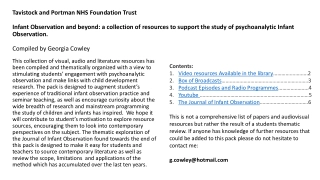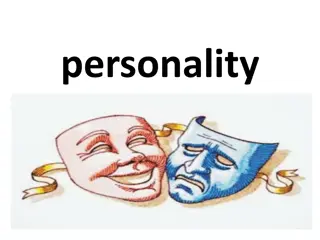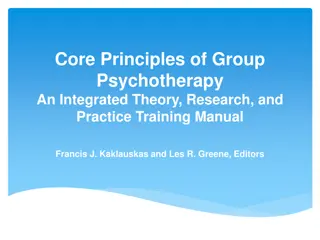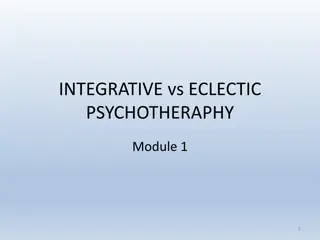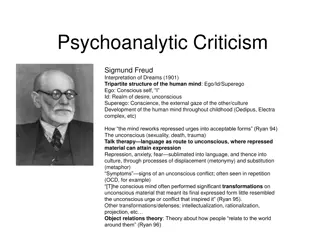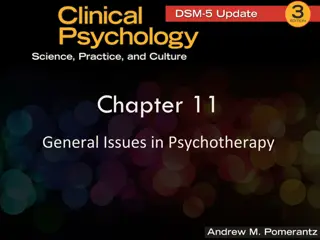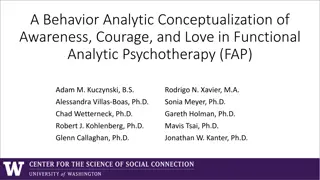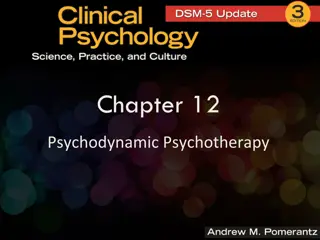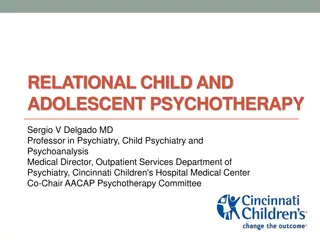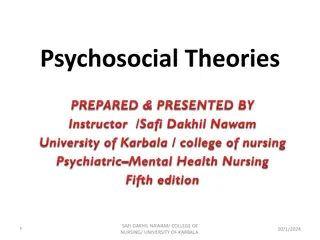Understanding Psychoanalytic Psychotherapy
Psychoanalytic psychotherapy aims to increase adaptive functioning by reducing symptoms, resolving conflicts, and fostering self-reflection. The therapy involves making the unconscious conscious, strengthening the ego, and exploring childhood experiences to increase self-awareness. Therapists maintain a neutral stance, encourage transference relationships, and focus on establishing a therapeutic alliance to help clients solve their own problems effectively through the reworking of old patterns.
Download Presentation

Please find below an Image/Link to download the presentation.
The content on the website is provided AS IS for your information and personal use only. It may not be sold, licensed, or shared on other websites without obtaining consent from the author. Download presentation by click this link. If you encounter any issues during the download, it is possible that the publisher has removed the file from their server.
E N D
Presentation Transcript
Psychoanalytic Psychotherapy
Therapeutic Goals The ultimate goal of psychoanalytic treatment is to increase adaptive functioning, which involves the reduction of symptoms and the resolution of conflicts The creation of an ability for self-reflection is aimed for, the capacity of the individual mind to take itself as the object of reflection in relation to the behavior of the self with others and of others toward the self. This is the ability to understand one s own and others behavior in terms of mental states (thoughts, feelings, intentions and motivations)
Goals (continued) Make the unconscious conscious Strengthen the ego so that behavior is based more on reality and less on instinctual cravings (from the id) or irrational guilt (from the superego) Methods used to bring out unconscious material Childhood experiences are reconstructed, discussed, interpreted, analyzed Deep probing into the past to increase self-awareness Feelings and memories associated with this self-awareness are experienced
Therapist Function and Role Blank screen approach = anonymous, non-judgmental stance; avoid self-disclosure, maintain sense of neutrality Transference relationship = the transfer of feelings originally experienced in an early relationship (i.e. parents) to other important people in the present (i.e. the therapist) Ideally, in classical psychoanalysis, if the therapist says little about themselves and rarely share personal reactions, whatever the client feels toward the therapist will mainly be the product of feelings toward significant figures in the past
Therapist Role Establishing a therapeutic alliance is a primary treatment goal The empathetic attunement to the client facilitates the analyst s appreciation of the client s intrapsychic world The psychoanalytic therapist pays attention to what is spoken and what remains unspoken, listens for gaps in stories, infers the meaning of reported dreams and free associations and remains sensitive to clues of what the client feels about the therapist
Aims/Process of Psychoanalytic Therapy The process is somewhat like putting the pieces of a puzzle together A central aim is to foster the capacity of clients to solve their own problems If the therapist pushes the client too quickly, or offers ill-timed interpretations, therapy will not be effective Change occurs through the process of reworking old patterns so that clients might be more free to act in new ways
Client Experience (Classical Psychoanalysis) Classical psychoanalysis an intensive, long-term therapy process Couch = after some face to face sessions, the client lies on a couch facing away from the therapist in the goal of engaging in free association (try and say whatever comes to mind without any self- censorship) Lying on the couch encourages deep, uncensored reflections; report feelings, experiences, memories, fantasies It also reduces the chance of reading the therapist s face for reactions, and fosters projections characteristic of transference
Client Experience (Classical Psychoanalysis) Unique relationship with the therapist Client is free to express any idea or feeling, no matter how irresponsible, scandalous, politically incorrect, selfish, infantile This structure allows for loosening defense mechanisms and regress It is essential for the analyst to keep the analytic situation safe Holding environment = Winnicott used the term holding to refer to the supportive environment that a therapist creates for a client. The concept can be likened to the nurturing and caring behavior a mother engages in with her child that results in a sense of trust and safety.
Winnicotts Holding Environment and Frame The frame that supports the analytic relationship is also referred to the holding environment The pragmatic features of the analytic frame consistency of the setting, the set length of time of sessions, use of the couch, demarcate the therapeutic space as different from other spaces Just as mothers provide the baby with a dependable, secure environment, the therapist s function to an extent mirrors the early parental function with its emphasis on responding to the patient s needs without impinging on them The safety of the frame is communicated in practical terms through the respect of the boundaries of the analytic relationship Managing the physical boundaries of the relationship a space where therapist and patient can meet without interruptions, where confidentiality is assured, where therapist can be relied upon to turn up on time, same time, week after week
Psychodynamic/Psychoanalytic Therapy vs Classical Psychoanalysis Shortens and simplifies the lengthy process of classical psychoanalysis Psychodynamic therapists still remain alert to transference, explore meanings of dreams, explores the past and present, offer interpretations for defenses and resistances and examine unconscious material Psychoanalytic psychotherapy fewer, less frequent sessions, sessions are usually face to face and therapist is more supportive
Psychodynamic Formulation A psychodynamic formulation is more than a story; it is a narrative that tries to explain how and why people think, feel, and behave the way they do based on their development. Cabaniss, D. L., Cherry, S., Douglas, C. J., Graver, R. L., & Schwartz, A. R. (2013). Psychodynamic formulation (1stEd.). John Wiley A news story gives a report of what happened; a psychodynamic formulation offers an hypothesis of why things happened. Here are two examples to illustrate the difference:
Reporting Mr D was born prematurely to a teenage mother who had a postpartum depression. He had severe separation anxiety as a child and spent long periods of time home sick. As an adult, he is unable to be away from his wife for more than one night. Formulating Mr D was born prematurely to a teenage mother who had a postpartum depression. He had severe separation anxiety as a child and spent long periods of time home sick. It is possible that his mother s depression affected Mr D s ability to develop a secure attachment and that this made it hard for him to think of himself as a separate person. This may have impeded his capacity to separate successfully from his mother. Now, it may be making it difficult for him to be apart from his wife for more than one night.
Psychodynamic formulations can explain one or many aspects of the way a person thinks, feels, or behaves. They can be based on a small amount of information (e.g., the history a clinician obtains during a single encounter in an emergency room) or an enormous amount of information (e.g., everything that a psychoanalyst learns about a patient during the course of an analysis). Having a working psychodynamic formulation means having a continuously evolving idea about the unconscious thoughts and feelings that affect our patients ways of thinking, feeling, and behaving. We listen carefully to what our patients say so that we can pick up clues that might guide us toward unconscious material, we reflect on what our patients say, and we intervene in ways that help them to learn more about their minds
Case of Ms. A. To further explore this, let s consider the example of Ms A. She is a 43-year-old woman who has come for treatment with Dr Z because she is worried that her husband will leave her. She explains that her husband is a genius and that she cannot understand why he wants to remain married to someone who just stays home and takes care of the children. She says: I ve become one of those boring housewives. The only thing I can talk about is the soccer schedule.
As Dr Z conducts the evaluation, she learns that Ms A is unable to say anything good about herself. Dr Z also recognizes that Ms A s self- effacement seems incongruous given her apparent abilities she was a gifted painter who gave up her career when she married. Dr Z begins to wonder about why Ms A has this view of herself. As Dr Z takes the developmental history, she learns that Ms A s mother was a world-famous scientist who was critical of her daughter s complete lack of interest in science, preferring Ms A s brother who became a physicist.
Dr Z constructs an early psychodynamic formulation (hypothesis) that Ms A has unconscious, maladaptive ways of perceiving herself and regulating her self-esteem and that these unconscious self- perceptions and conflicts might have developed as a result of Ms A s problematic relationship with her mother. Although Dr Z knows that she has much more to learn about Ms A, she uses her preliminary formulation to make a treatment recommendation and to work with Ms A to set early goals,
It is clear to me that you are worried about your relationship with your husband. However, it also seems that you are overly tough on yourself and that you do not allow yourself to do things that interest you. These difficulties could be related to longstanding feelings you have about yourself that may date back to your early relationship with your mother. Exploring these feelings in a psychodynamic psychotherapy may help us to understand why you are so unhappy in your current situation and help you to improve both your relationship and your feelings about yourself.
Ms A agrees and she and Dr Z begin a twice-a-week psychodynamic psychotherapy. Dr Z uses her hypothesis that Ms A was not able to develop an adequate sense of self to understand that M has a developmental need to improve her self-perception and her capacity for self-esteem regulation. This forms the basis for Dr Z s therapeutic strategy; she will listen to everything that Ms A says, paying close attention to material that might relate to Ms A s difficulties with her sense of self.
We follow the same steps when we construct psychodynamic formulations to help us understand how and why people develop their characteristic patterns of thinking, feeling, and behaving. This process involves three basic steps. We DESCRIBE the primary problems and patterns REVIEW the developmental history LINK the problems and patterns to the history using organizing ideas about development
DESCRIBE the primary patterns and problems Before we think about why people developed their primary problems and patterns, we have to be able to describe what they are. Here, we re not just talking about the chief complaint, but about the issues that underlie the person s predominant ways of thinking, feeling, and behaving. We can divide these into five basic areas of function: self relationships adapting cognition work and play
Our goal is to learn everything we can about our patients in order to begin to make links between their histories and the development of their primary problems and patterns. To do this, we have to take a developmental history. This kind of history begins before birth, with the patient s family of origin, prenatal development, and genetic endowment; it includes every aspect of the first years of life, including attachment, early relationships with caregivers, and trauma, and it continues through later childhood, adolescence, and adulthood, until the present moment.
The final step in constructing a psychodynamic formulation is linking the problems and patterns to the developmental history to form a longitudinal narrative that offers hypotheses about how and why the patient developed his/her ways of thinking, feeling, and behaving. In doing this, we can be helped by organizing ideas about development. These organizing ideas offer us different ways of conceptualizing and understanding our patients developmental experiences. They help us to take the information that we have learned from the history and think about how it could have led to the problems and patterns we see in our patients.
address the impact of the following on development: trauma early cognitive and emotional difficulties conflict and defense relationships with others the development of the self attachment
Like most people, these people are mosaics, with good function in one area and more difficulty in another. Sometimes, as mental health professionals, we focus exclusively on problems and neglect areas of strength and resilience. However, we need to rely on our patients strengths to help them build new, healthier ways of functioning. Describing our patients strengths and difficulties allows us to hypothesize about both in our psychodynamic formulations.
People are aware of some, but not all, of the ways in which they think, feel, and behave. Consider Ms J and Ms K: Ms J is a 35-year-old woman who presents for therapy saying, I have so much trouble feeling good about myself. I ve always been like that, ever since I was a child. It s something I d like to work on. Ms K is a 35-year-old woman who presents for therapy saying, My husband said that it was either therapy or divorce. He says that I don t listen to him. Why should I? He drones on all the time about his work accounting what could be more boring? By the way, you need a new receptionist. She mispronounced my name twice not too bright. Ms J is conscious that she has difficulties with self-esteem, even if she s not aware of why she does. Conversely, we can hypothesize that Ms K has unconscious difficulties with self-esteem, which are suggested by her tendency to belittle others in order to feel good about herself. When we think psychodynamically, we are interested in both conscious and unconscious patterns.
Everything we do in life, from having relationships with others to choosing what we do for work and play, relates to how we think about ourselves that is, to our self-experience. Having a realistic idea of what we can do and what we like to do helps us to choose relationships and activities that bring us satisfaction and pleasure and to maintain good feelings about ourselves even in the face of adversity. Thus, our self-experience is central to the way we function. We can describe a person s self-experience using two major variables: self-perception self-esteem regulation
Adults with a secure sense of identity use it to make choices about everything, from relationships to career options. Adults with a less secure sense of identity often have difficulty making choices and may have a more erratic life trajectory. Consider the following examples: Mr A is a 27-year-old gay man who is in a master s program in engineering. In college, he did well as a chemistry major and then took an inspiring engineering class; he is now hoping to combine his interests by specializing in chemical engineering. He says, I m good at math and science, but not so great at writing, so even though I once thought I wanted to write novels I think that s not in the cards and I really enjoy what I m doing. He is in a long-term relationship and hopes one day to have children with his partner. Mr B is a 27-year-old heterosexual man who is working as a waiter and living with college friends. He says, I should figure out something else to do but I don t know what that would be. I studied biology in college because my parents told me I should but I kind of hated it. Maybe I ll try writing a novel . . . seems like a good way to make some money but I don t know if I m much of a writer. Mr B has had brief, intense relationships with women and says, I don t think I ve ever dated someone I liked all that much. Although they are at similar points in their lives, Mr A has a much more consolidated sense of identity than Mr B. Mr A is comfortable with his likes and dislikes, both in work and in his relationships, and he has a good sense of his talents and limitations. On the contrary, Mr B is unsure of what he enjoys and is not able to identify his strengths and difficulties.
The ability to pick oneself up after disappointments or slights is called self-esteem regulation and is an important part of how people function in the world [11, 12]. Anything that imperils a person s good feelings about himself/herself is a self- esteem threat (also called a narcissistic injury) [13]. Since people vary in the way they perceive and respond to self-esteem threats, we can use the following variables to describe individual patterns of self-esteem regulation: vulnerability to self-esteem threats internal response to self-esteem threats use of others to help regulate self-esteem
Learning about self-perception Sometimes direct questions about identity and fantasies can be helpful. For example: Do you think that you have an accurate sense of your strengths and difficulties? What do others say about that? Do they tend to think that you can do more than you think that you can? Do you think that you won t be able to do things that you actually can or is it the other way around? Would people describe you as someone who knows who he/she is?
Learning about self-esteem vulnerability Asking direct questions about envy, jealousy, and self-esteem vulnerability can make people anxious and defensive. Instead, try asking questions about common situations to learn about this area: How do you feel when you re in a group of people who seem to be wealthier/more accomplished/more highly educated than you are? Tell me about a time when you didn t get something you really wanted. How did it make you feel? How do you feel when a friend accomplishes something that you haven t been able to do? All people have things that make them feel less than good about themselves. What kinds of things make you feel that way?
Learning about internal responses to self-esteem threats Listen for stories that have to do with disappointments or failures, and ask questions that will help you to learn about the person s response. For example: Do you tend to feel that others around you are incompetent? Do you generally feel like the smartest/least intelligent person in the room? Do you think that people would tend to describe you as a competitive person? How do you generally go about getting something you want? Learning about use of others for self-esteem regulation Do you know when you ve done a good job without needing to hear praise from others? Are you able to make decisions without input from others?
How would you describe Mr As patterns related to the self? Mr A is a 43-year-old man who is married and has two children. He has had many different jobs over the years he drifts from job to job without a real sense of direction. At one point, he decided that he wanted to be an artist and gave up his job, rented a nearby garage, and began painting despite never having had any art training. He has contempt for people who settle for mainstream careers, despite the fact that he often envies their lifestyles. They re working stiffs, but they get everything good in life, he complains. His wife and children have followed him in his meanderings when they get frustrated, he says that they don t appreciate him.
Mr A has difficulty with self-perception and self-esteem regulation. His sense of identity is poorly formed, as evidenced by his vague career trajectory. His attempt to become a painter without training or indication of aptitude suggests that his fantasies about himself are not consonant with his realistic talents and limitations. He regulates self-esteem by becoming grandiose and contemptuous of others, and he is exquisitely vulnerable to self-esteem threats. His lack of empathy for the difficulties he is causing his family members suggests that he uses others to help regulate his self-esteem.
Relationship Between Therapist and Client Contemporary psychodynamic therapists focus as much as on the here and now transference as on earlier memories Analytic therapy focuses on feelings, perceptions and action that are happening in the moment in the therapy session The therapeutic relationship is central to increasing client self- awareness, self-understanding and exploration
Transference A significant aspect of the therapeutic relationship is manifested through transference reactions Transference = the client s unconscious shifting to the therapist of feelings, attitudes and fantasies (positive and negative) that are reactions from the client s past It is the unconscious repetition of the past in the present Client has negative and positive reactions to the therapist When these feelings become conscious and are transferred to the therapist, clients can understand and resolve past unfinished business
Transference The therapist becomes a substitute for past significant others For example, clients may transfer unresolved feelings toward a stern, unloving father to the therapist who, in their eyes, becomes stern and unloving A client may also develop a positive transference, fall in love with the therapist, wish to be adopted, or may seek the love, acceptance and approval of an all-powerful therapist Working through = repetitive and elaborate explorations of unconscious material and defenses, most of which originated in early childhood, learn to accept defensive structures and recognize how they served a purpose in the past
Transference Regardless of the length of psychoanalytic therapy, traces of our childhood needs and traumas will never be completely erased Infantile conflicts may never be fully resolved We may struggle at times with feelings that we project onto others as well as unrealistic demands we expect others to satisfy Some client reactions are not just transference but reactions to the here and now, a client s anger towards a therapist may be due to the therapist s actual behavior
Countertransference Countertransference = a therapist s unconscious emotional response to a client based on the therapist s own past, resulting in a distorted perception of the client s behavior May include withdrawal, anger, love, annoyance, powerlessness, avoidance, overidentification, control or sadness To avoid misunderstanding and overidentification with clients, the analytic approach requires therapists to undergo their own analytic psychotherapy (McWilliams, 2014) Personal therapy and clinical supervision for therapists can be helpful in understanding how internal reactions influence the therapy
Countertransference Not all countertransference reactions are detrimental to therapy progress, they are sometimes sources of data for understanding the world of the client For example, a therapist who notes a countertransference mood of irritability may learn something about a client s pattern of being demanding, which can be explored in therapy Therapists vary in the manner in which they use their observations of countertransference The ability of therapists to gain self-understanding and to establish appropriate boundaries is critical in using countertransference reactions
Key Interventions in Psychoanalytic Therapy Interpretation, free association, dream analysis, analysis/interpretation of resistance, analysis/interpretation of transference Interpretation originally defined as bringing the unconscious into consciousness Nowadays, it is also defined as interventions that address interpersonal themes and make important links between patterns of relating to significant others and to the therapist It is the analyst pointing out, explaining, and even teaching the client the meanings of their behavior that is manifested in dreams, free association, resistances, defenses and the therapeutic relationship itself
Interpretations Includes identifying, clarifying and translating the client s material Presented in a collaborative manner to help clients make sense of their lives and to expand their consciousness The therapist should use the client s reactions as a gauge in determining a client s readiness to share an interpretation The therapist should interpret material that the client has not yet seen but should be capable of tolerating and taking in
Dream Analysis During sleep, defenses are lowered and repressed feelings surface Dreams have two levels of content: latent and manifest The manifest content of your dreams is what happens on the surface of the dream. That is often compared to the latent content of dreams, which is what the manifest content represents or symbolizes. Imagine you dreamed that you went to the store, and while in the checkout line realized that you were naked. The manifest content of this dream is the actual event: being naked in the line at the store. However, being naked in public (a common dream) often represents feelings of vulnerability. Those feelings - the deeper meaning of the dream - are latent content.
Dream Analysis During the session, the therapist might ask client to free associate some aspect of the manifest content of a dream for the purpose of uncovering the latent meanings Therapists explore client s associations with the dreams Interpreting the meanings of the dreams helps clients unlock the repression that has kept the material from consciousness and relate the new insight to their present struggles Dreams provide an understanding of client s current functioning
Resistance Resistance is anything that works against the progress of therapy and prevents the client from producing previously unconscious material, the reluctance to bring to the surface of awareness unconscious material that has been repressed Clients tend to cling to their familiar patterns, regardless of how painful they may be; therapists need to create a safe climate so clients can recognize resistance and explore it in therapy Therapists point out and interpret the most obvious resistances to lessen the probability of clients rejecting the interpretation For example, if a client in psychotherapy is uncomfortable talking about his or her father, they may show resistance around this topic.
Contemporary Trends: Object Relations Theory, Self Psychology and Relational Psychoanalysis Object Relations Theory Object relations is a variation of psychoanalytic theory that diverges from Sigmund Freud s belief that humans are motivated by sexual and aggressive drives, suggesting instead that humans are primarily motivated by the need for contact with others the need to form relationships. The aim of an object relations therapist is to help an individual in therapy uncover early mental images that may contribute to any present difficulties in one s relationships with others and adjust them in ways that may improve interpersonal functioning.
Object Relations Theory Object relations theorists stress the importance of early family interactions, primarily the mother-infant relationship, in personality development. It is believed that infants form mental representations of themselves in relation to others and that these internal images significantly influence interpersonal relationships later in life. Since relationships are at the center of object relations theory, the person-therapist alliance is important to the success of therapy.
Object Relations Theory The term object relations refers to the dynamic internalized relationships between the self and significant others (objects). An object relation involves mental representations of: The object as perceived by the self The self in relation to the object The relationship between self and object For example, an infant might think: "My mother is good because she feeds me when I am hungry" (representation of the object). "The fact that she takes care of me must mean that I am good" (representation of the self in relation to the object). "I love my mother" (representation of the relationship).
Object Relations Theory Object relations theory is composed of the diverse and sometimes conflicting ideas of various theorists, mainly Melanie Klein, Ronald Fairbairn, and Donald Winnicott. Each of their theories place great emphasis on the mother-infant bond as a key factor in the development of a child s psychic structure during the first three years of life. Klein is often credited with founding the object relations approach. From her work with young children and infants, she concluded that they focused more on developing relationships, especially with their caregivers, than on controlling sexual urges, as Freud had proposed. Klein also focused her attention on the first few months of a child s life, whereas Freud emphasized the importance of the first few years of life. Fairbairn agreed with Klein when he posited that humans are object-seeking beings, not pleasure-seeking beings. He viewed development as a gradual process during which individuals evolve from a state of complete, infantile dependence on the caregiver toward a state of interdependency, in which they still depend on others but are also capable of being relied upon. Winnicott stressed the importance of raising children in an environment where they are encouraged to develop a sense of independence but know that their caregiver will protect them from danger. He suggested that if the caregiver does not attend to the needs and potential of the child, the child may be led to develop a false self. The true self emerges when all aspects of the child are acknowledged and accepted.
Self Psychology Self psychology, an offshoot of Freud s psychoanalytic theory, forms much of the foundation of contemporary psychoanalysis as the first large psychoanalytic movement recognizing empathy as an essential aspect of the therapeutic process of addressing human development and growth. Self psychology theory, which rejects Freudian ideology of the role sexual drives play in organization of the psyche, focuses on the development of empathy toward the person in treatment and the exploration of fundamental components of healthy development and growth. Therapistsmay use self psychology theory in part to help people consider how their early experiences may contribute to the formation of their sense of self.
Self Psychology In self psychology, the self is understood to be the center of an individual s psychological universe. If a child s developmental environment is appropriate, a healthy sense of self will typically develop, and generally the individual will be able to maintain consistent patterns/experiences and self-regulate and self-soothe throughout life. When individuals are not able to develop a healthy sense of self, they may tend to rely on others in order to get needs met. These others are called selfobjects (because they are outside the self). Selfobjects are a normal part of the developmental process, according to Kohut. Children need selfobjects because they are incapable of meeting all of their own needs, but over the course of healthy development, selfobjects become internalized as individuals develop the ability to meet their own needs without relying on external others.



